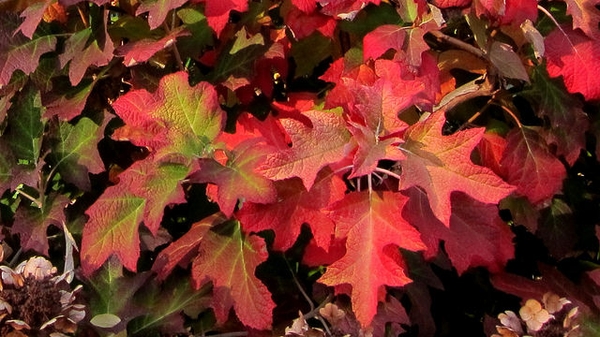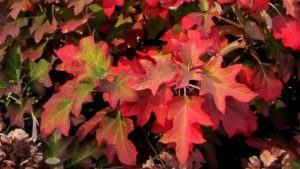Bringing Autumn’s Color into Your Landscape
By Thomas Christopher
This time of year brings the gaudiest, most glorious show to the northeast, as the foliage of our trees turns to incandescent yellows, oranges and scarlets. This explosion of color might seem likely to overwhelm any plans you might have for your own garden display. In fact, though, there’s an easy way for the gardener to take advantage of and domesticate the natural extravaganza.
To do this involves employing a technique used in traditional Japanese gardening called shakkei. The literal meaning of this word is “borrowed scenery.” The basic idea is that you create a link between the surrounding landscape and the garden, so that the two function as a single unit. There are a number of ways to accomplish this, but the one that is most relevant here is to create an echo. That is, you include in your design some element that repeats a vista’s most prominent feature. You could, for example, plant some shrub or shrubs in your beds whose foliage turns bright colors in the fall. By confronting the viewer with your own splash of autumn foliage, your bring into your landscape and take possession of the riot of color all around you.
There are lots of options for creating such an echo. It’s easy enough to find lists of shrubs and small trees with colorful autumn foliage. Most though, focus heavily on plants of foreign background. I prefer to use natives, for two reasons. First because the native shrubs typically have greater food value for native pollinators and other forms of wildlife. Then, too, any time you introduce an exotic species, you take a chance on releasing an invasive plant. In point of fact, two of our region’s most troublesome invasive shrubs, the so-called “burning bush” (Euonymus alatus) and the Japanese barberry (Berberis thunbergii), found popularity among gardeners largely due to the attractive hues that their foliages turn in fall.
Fortunately, there are lots of fine alternatives of native North American origin.
One of the most striking is the oakleaf hydrangea (Hydrangea quercifolia). Strictly speaking, this is a native of the southeastern United States, but it integrates into our landscape easily, thriving in full sun or part shade, and is hardy to USDA zone 5. It’s commonly cultivated for the large cones of white flowers it bears in late June to early July – these turn pinkish purple as the summer progresses — but the fall color of its bold, toothed, oak-like leaves is even more spectacular in my opinion. As the weather cools, the leaves turn a variety of shades from burgundy to pink, red, orange and yellow.
The most brilliant scarlet of a native autumn is surely that of the staghorn sumac (Rhus typhina). The wild type plant makes a somewhat coarse shrubby tree 15 to 25 feet tall, too large for most gardens. There’s a dwarf cultivar sold as “Tiger Eyes” however, which makes a six-foot by six-foot mound of bright yellow leaves that turn orange and scarlet in fall. This shrub grows in full sun to part shade, and is hardy to USDA zone 4.
Another native of the eastern woodlands is the common witch hazel (Hamamelis virginiana). It needs a large spot, as it matures to a height of 15 to 20 feet; flourishing in sun or part shade, it’s hardy to USDA zone 3. Its foliage colors bright yellow in the fall, and when the leaves drop, this shrub encores with a late bloom of fragrant yellow flowers that can persist into December.
Better suited to small gardens is the dwarf fothergilla (Fothergilla gardenii) which makes small, mounded shrub two to three feet wide and high. It’s sure to catch your eye in fall with the luminous oranges, reds, and yellows of its foliage; it’s also a star of early spring, bearing sweetly scented white, bottlebrush-like flowers before it leafs out. Full sun to part shade, hardy to zone 5.
Space prevents me from describing all the native shrubs outstanding for their fall foliage colors, but I cannot close without at least mentioning blueberries, both highbush and lowbush (Vaccinium corymbosum and angustifolium – bright red autumn foliage), arrowwood viburnum (Viburnum dentatum – yellow, orange and red fall foliage) and Virginia sweetspire (Itea virginica – red, orange and gold). Any of these, or the shrubs described above, will empower you to borrow the scenery of the surrounding hills and valleys, and without a penny in closing costs or interest.
Thomas Christopher is the co-author of “Garden Revolution” (Timber Press, 2016) and is a volunteer at Berkshire Botanical Garden. berkshirebotanical.org
Be-a-Better-Gardener is a community service of Berkshire Botanical Garden, one of the nation’s oldest botanical gardens in Stockbridge, MA. Its mission to provide knowledge of gardening and the environment through 25 display gardens and a diverse range of classes informs and inspires thousands of students and visitors on horticultural topics every year. Thomas Christopher is the co-author of Garden Revolution (Timber press, 2016) and is a volunteer at Berkshire Botanical Garden. berkshirebotanical.org.




